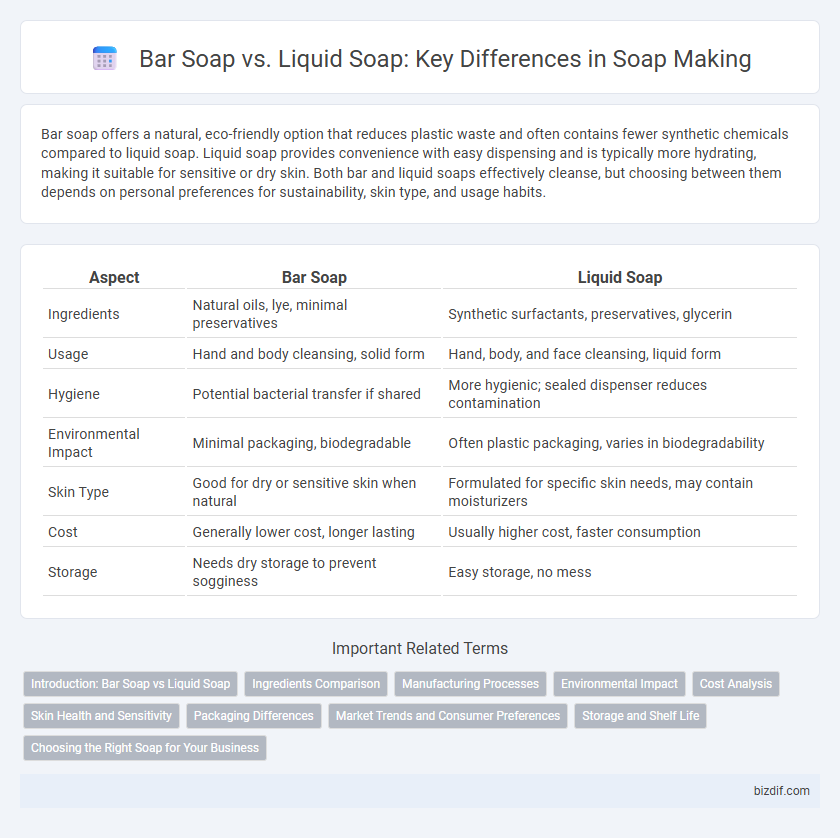Bar soap offers a natural, eco-friendly option that reduces plastic waste and often contains fewer synthetic chemicals compared to liquid soap. Liquid soap provides convenience with easy dispensing and is typically more hydrating, making it suitable for sensitive or dry skin. Both bar and liquid soaps effectively cleanse, but choosing between them depends on personal preferences for sustainability, skin type, and usage habits.
Table of Comparison
| Aspect | Bar Soap | Liquid Soap |
|---|---|---|
| Ingredients | Natural oils, lye, minimal preservatives | Synthetic surfactants, preservatives, glycerin |
| Usage | Hand and body cleansing, solid form | Hand, body, and face cleansing, liquid form |
| Hygiene | Potential bacterial transfer if shared | More hygienic; sealed dispenser reduces contamination |
| Environmental Impact | Minimal packaging, biodegradable | Often plastic packaging, varies in biodegradability |
| Skin Type | Good for dry or sensitive skin when natural | Formulated for specific skin needs, may contain moisturizers |
| Cost | Generally lower cost, longer lasting | Usually higher cost, faster consumption |
| Storage | Needs dry storage to prevent sogginess | Easy storage, no mess |
Introduction: Bar Soap vs Liquid Soap
Bar soap offers a traditional, solid form of cleansing product made from saponified fats and oils, providing a longer-lasting and eco-friendly option with minimal packaging waste. Liquid soap, formulated with water, surfactants, and moisturizers, delivers convenience and enhanced hygiene through controlled dispensing and reduced cross-contamination. Choosing between bar soap and liquid soap depends on factors such as skin type, usage environment, and personal preference for texture and scent retention.
Ingredients Comparison
Bar soap typically contains natural oils, lye (sodium hydroxide), and minimal synthetic additives, resulting in a solid form that is easier to formulate with fewer preservatives. Liquid soap uses potassium hydroxide instead of sodium hydroxide and often includes additional humectants, stabilizers, and preservatives to maintain its consistency and shelf life. The ingredient differences impact cleansing efficacy, skin feel, and environmental footprint, with bar soaps generally having a simpler, more biodegradable composition.
Manufacturing Processes
Bar soap manufacturing typically involves a saponification process where oils react with an alkali, followed by molding and curing to harden the soap. Liquid soap production requires precise formulation with potassium hydroxide instead of sodium hydroxide, ensuring a fluid, stable consistency through continuous mixing and heating. Both processes demand quality control to maintain pH balance, fragrance stability, and cleansing effectiveness.
Environmental Impact
Bar soap generates less plastic waste compared to liquid soap, as it typically comes with minimal or no packaging. The production of liquid soap often requires more water and energy, contributing to a larger carbon footprint. Biodegradability of bar soap ingredients generally exceeds that of liquid soap formulations, reducing long-term environmental harm.
Cost Analysis
Bar soap generally offers a more cost-effective option compared to liquid soap, with the average price per use being significantly lower due to its concentrated form and minimal packaging expenses. Liquid soaps often require more packaging and preservatives, driving up both manufacturing and retail costs, which results in a higher price per ounce. When considering long-term usage, bar soap provides greater value by lasting longer and reducing overall expenditure on personal hygiene products.
Skin Health and Sensitivity
Bar soap typically contains fewer synthetic additives and preservatives, making it a preferable choice for sensitive skin prone to irritation or allergies. Liquid soaps often include moisturizing agents and antibacterial ingredients, which can help maintain skin hydration but may also cause dryness or disrupt the skin's natural microbiome for some users. Choosing between bar and liquid soap depends on individual skin type, with bar soap favored for gentle cleansing and liquid soap suited for enhanced hydration and targeted skin concerns.
Packaging Differences
Bar soap typically uses minimal packaging such as paper wrappers or cardboard boxes, which are biodegradable and environmentally friendly. Liquid soap requires plastic bottles or pump dispensers that can be more resource-intensive to produce and often less sustainable. Choosing bar soap reduces plastic waste and supports eco-friendly packaging alternatives.
Market Trends and Consumer Preferences
Bar soap remains popular due to its environmental benefits and lower cost, capturing significant market share among eco-conscious consumers. Liquid soap sees steady growth driven by convenience, hygiene perception, and the rise of premium formulations with moisturizing ingredients. Market trends indicate a segment shift as consumers balance sustainability concerns with ease of use, influencing product innovation and retail strategies.
Storage and Shelf Life
Bar soap typically has a longer shelf life, lasting up to three years when stored in a cool, dry place away from direct sunlight and moisture. Liquid soap, containing water, is more prone to microbial growth and usually has a shelf life of about one to two years, often requiring preservatives to maintain quality. Proper storage in airtight containers for liquid soap and well-ventilated holders for bar soap helps prevent degradation and extends usability.
Choosing the Right Soap for Your Business
Bar soap offers a lower cost per use and generates less packaging waste, making it an eco-friendly option for businesses aiming to reduce environmental impact. Liquid soap provides convenience and ease of use with built-in dispensers, ideal for high-traffic commercial settings requiring frequent handwashing. Consider factors such as customer preferences, hygiene standards, and budget constraints to select the most efficient and sustainable soap solution for your business.
Bar Soap vs Liquid Soap Infographic

 bizdif.com
bizdif.com